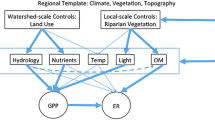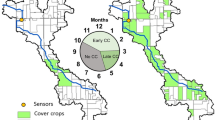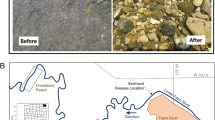Abstract
We evaluated the ecological effectiveness of an in-stream restoration project involving coarse woody debris (CWD) additions to streams along an upland soil and vegetation disturbance gradient at the Fort Benning Military Installation near Columbus, GA. We examined short-term (immediate effectiveness) and longer-term (sustainability) responses to CWD additions by measuring ecosystem metabolism rates in 8 streams quarterly over a 6-year period, including 3 years before (2001–2003) and 3 years after (2004–2006) CWD additions that were made to half of the streams. Ecosystem respiration (ER) rates in most CWD addition streams increased relative to control streams from spring 2004 through autumn 2005, suggesting heterotrophic bacteria were the initial responders to CWD additions. Gross primary production (GPP) rates remained low (typically < 0.3 g O2 m−2 d−1) but increased in some CWD addition streams relative to control streams in spring 2004 and 2005. The magnitude of ER increases in CWD addition streams during the first two years post-addition increased with catchment disturbance intensity, indicating that more heavily disturbed streams responded most strongly to restorations—an important consideration when targeting future restoration locations. Because restorations did not address actual upland disturbance, continued high erosion rates resulted in 32–77% of the added CWD being buried by year two and a corresponding return of GPP and ER rates to pre-CWD addition levels by year three. If restoration projects do not adequately address the source of catchment disturbances, CWD additions will provide only short-term increases in streambed structure and stability, hydrodynamic complexity, and nutrient and organic matter processing and retention.





Similar content being viewed by others
References
Abell RA, Olson DM, Dinerstein E, Hurley PT, Diggs JT, Eichbaum W, Walters S, Wettengel W, Allnutt T, Loucks CJ, Hedao P. 2000. Freshwater ecoregions of North America: a conservation assessment. Washington, DC: Island Press. p 368p.
Allan JD. 2004. Landscapes and riverscapes: the influence of land use on stream ecosystems. Annual Review of Ecology, Evolution, and Systematics 35:257–284.
Arango CP, James PW, Hatch KB. 2015. Rapid ecosystem response to restoration in an urban stream. Hydrobiologia 749:197–211.
Atkinson BL, Grace MR, Hart BT, Vanderkruk KEN. 2008. Sediment instability affects the rate and location of primary production and respiration in a sand-bed stream. Journal of the North American Benthological Society 27:581–592.
Aust WM, Blinn CR. 2004. Forestry best management practices for timber harvesting and site preparation in the eastern United States: an overview of water quality and productivity research during the past 20 years (1982–2002). Water, Air, and Soil Pollution 4:5–36.
Beaulieu JJ, Arango CP, Balz DA, Shuster WD. 2013. Continuous monitoring reveals multiple controls on ecosystem metabolism in a suburban stream. Freshwater Biology 58:918–937.
Becker JF, Endreny TA, Robinson JD. 2013. Natural channel design impacts on reach-scale transient storage. Ecological Engineering 57:380–392.
Bernhardt ES, Palmer MA, Allan JD, Alexander G, Barnas K, Brooks S, Carr J, Clayton S, Dahm C, Follstad-Shah J, Galat D, Gloss S, Goodwin P, Hart D, Hassett B, Jenkinson R, Katz S, Kondolf GM, Lake PS, Lave R, Meyer JL, O’Donnell TK, Pagano L, Powell B, Sudduth E. 2005. Synthesizing US river restoration efforts. Science 308:636–637.
Bernhardt ES, Heffernan JB, Grimm NB, Stanley EH, Harvey JW, Arroita M, Appling AP, Cohen MJ, McDowell WH, Hall RO Jr, Read JS, Roberts BJ, Stets EG, Yackulic CB. 2018. The metabolic regimes of flowing waters. Limnology and Oceanography 63:S99–S118.
Bilby RE. 1981. Role of organic debris dams in regulating the export of dissolved and particulate matter from a forested watershed. Ecology 62:1234–1243.
Bilby RE, Bison PA. 1998. Function and distribution of large woody debris. In: Naiman RJ, Bilby RE, Eds. River ecology and management: lessons from Pacific coastal ecoregion, . New York: Springer. pp 324–346.
Bilby RE, Likens GE. 1980. Importance of organic matter debris dams in the structure and function of stream ecosystems. Ecology 61:1107–1113.
Bohn BA, Kershner JL. 2002. Establishing aquatic restoration priorities using a watershed approach. Journal of Environmental Management 64:355–363.
Bukaveckas PA. 2007. Effects of channel restoration on water velocity, transient storage, and nutrient uptake in a channelized stream. Environmental Science & Technology 41:1570–1576.
Bunn SE, Davies PM, Mosisch TD. 1999. Ecosystem measures of river health and their response to riparian and catchment degradation. Freshwater Biology 41:333–345.
Colangelo DJ. 2007. Response of river metabolism to restoration of flow in the Kissimmee River, Florida, U.S.A. Freshwater Biology 52:459–470.
Craig LS, Palmer MA, Richardson DC, Filoso S, Bernhardt ES, Bledsoe BP, Doyle MW, Groffman PM, Hassett BA, Kaushal SS, Mayer PM, Smith SM, Wilcock PR. 2008. Stream restoration strategies for reducing river nitrogen loads. Frontiers in Ecology and the Environment 6:529–538.
Ensign SH, Doyle MW. 2005. In-channel transient storage and associated nutrient retention: evidence from experimental manipulations. Limnology and Oceanography 50:1740–1751.
Entrekin SA, Tank JL, Rosi-Marshall EJ, Hoellein TJ, Lamberti GA. 2009. Response of secondary production by macroinvertebrates to large wood addition in three Michigan streams. Freshwater Biology 54:1741–1758.
Felley JD. 1992. Medium-low-gradient streams of the Gulf Coast Plain. In: Hackney CT, Adams SM, Martin WH, Eds. Biodiversity of the southeastern United States: aquatic communities, . New York: John Wiley and Sons. pp 233–269.
Fellows CS, Clapcott JE, Udy JW, Bunn SE, Harch BD, Smith MJ, Davies PM. 2006. Benthic metabolism as an indicator of stream ecosystem health. Hydrobiologia 572:71–87.
Green RH. 1979. Sampling design and statistical methods for environmental biologists. Chichester (UK): Wiley Interscience. p 272.
Gregory SV, Boyer K, Gurnell AM, editors. 2003. The ecology and management of wood in world rivers. American Fisheries Society Symposium 37. Bethesda (Maryland): American Fisheries Society. 444p.
Gregory SV, Swanson FJ, McKee WA, Cummins KW. 1991. An ecosystem perspective of riparian zones. Bioscience 41:540–551.
Griffiths NA, Tank JL, Royer TV, Roley SS, Rosi-Marshall EJ, Whiles MR, Beaulieu JJ, Johnson LT. 2013. Agricultural land use alters the seasonality and magnitude of stream metabolism. Limnology and Oceanography 58:1513–1529.
Grimm NB, Fisher SG. 1984. Exchange between interstitial and surface water: implications for stream metabolism and nutrient cycling. Hydrobiologia 111:219–228.
Gurtz ME, Webster JR, Wallace JB. 1980. Seston dynamics in southern Appalachian streams–effects of clear-cutting. Canadian Journal of Fisheries and Aquatic Sciences 37:624–631.
Harmon ME, Franklin JF, Swanson FJ, Sollins P, Gregory SV, Lattin JD, Anderson NH, Cline SP, Aumen NG, Sedell JR, Lienkaemper GW, Cromack K, Cummins KW. 1986. Ecology of coarse woody debris in temperate ecosystems. Advances in Ecological Research 15:133–302.
Hilderbrand RH, Watts AC, Randle AM. 2005. The myths of restoration ecology. Ecology and Society 10:19.
Hill WR, Ryon MG, Schilling EM. 1995. Light limitation in a stream ecosystem–responses by primary producers and consumers. Ecology 76:1297–1309.
Hoellein TJ, Tank JL, Rosi-Marshall EJ, Entrekin SA. 2009. Temporal variation in substratum-specific rates of N uptake and metabolism and their contribution at the stream-reach scale. Journal of the North American Benthological Society 28:305–318.
Hoellein TJ, Tank JL, Entrekin SA, Rosi-Marshall EJ, Stephen ML, Lamberti GA. 2012. Effect of benthic habitat restoration on nutrient uptake and ecosystem metabolism in three headwater streams. River Research and Applications 28:1451–1461.
Houser JN, Mulholland PJ, Maloney KO. 2005. Catchment disturbance and stream metabolism: patterns in ecosystem respiration and gross primary production along a gradient of upland soil and vegetation disturbance. Journal of the North American Benthological Society 24:538–552.
Houser JN, Mulholland PJ, Maloney KO. 2006. Upland disturbance affects headwater stream nutrients and suspended sediments during baseflow and stormflow. Journal of Environmental Quality 35:352–365.
Huryn AD, Huryn VMB, Arbuckle CJ, Tsomides L. 2002. Catchment land-use, macroinvertebrates and detritus processing in headwater streams: taxonomic richness versus function. Freshwater Biology 47:401–415.
Hynes HBN. 1975. The stream and its valley. Verhandlungen, Internationale Vereinigung fur Theoretische und Augewandte Limnologie 19:1–15. http://www.umag.cl/facultades/williams/wp-content/uploads/2016/11/HynesTheStreamAndItsValley-1975.pdf.
Johnson TAN, Kaushal SS, Mayer PM, Smith RM, Sivirichi GM. 2016. Nutrient retention in restored streams and rivers: a global review and synthesis. Water 8:116.
Kane S, Keeton R. 1998. Fort Benning: the land and the people. Prepared by the National Park Service, Southeast Archaeological Center, Tallahassee, Florida, for the US Army Infantry Center, Directorate of Public Works, Environmental Management Division, Fort Benning, Georgia. (Available from: US Army Infantry Center, Directorate of Public Works, Environmental Management Division, Harmony Church, Fort Benning, Georgia 31905 USA).
Kasahara T, Hill AR. 2006. Effects of riffle-step restoration on hyporheic zone chemistry in N-rich lowland streams. Canadian Journal of Fisheries and Aquatic Sciences 63:120–133.
Kaushal SS, Groffman PM, Mayer PM, Striz E, Gold AJ. 2008. Effects of stream restoration on denitrification in an urbanizing watershed. Ecological Applications 18:789–804.
Kupilas B, Hering D, Lorenz AW, Knuth C, Gücker B. 2017. Hydromorphological restoration stimulates river ecosystem metabolism. Biogeosciences 14:1989–2002.
Lake PS, Bond N, Reich P. 2007. Linking ecological theory with stream restoration. Freshwater Biology 52:597–615.
Likens GE, Bormann FH, Johnson NM, Fisher DW, Pierce RS. 1970. Effects of forest cutting and herbicide treatment on nutrient budgets in Hubbard Brook watershed-ecosystem. Ecological Monographs 40:23–47.
Lowrance R, Todd R, Fail J, Hendrickson O, Leonard R, Asmussen L. 1984. Riparian forests as nutrient filters in agricultural watersheds. Bioscience 34:374–377.
Maloney KO, Mulholland PJ, Feminella JW. 2005. Influence of catchment-scale military land use on stream physical and organic matter variables in small southeastern plains catchments (USA). Environmental Management 35:677–691.
Mitchell RM. 2009. The Influence of Coarse Woody Debris, Disturbance, and Restoration on Biological Communities in Sandy Coastal Plain Streams. Ph.D. Dissertation. http://hdl.handle.net/10415/2022. Auburn (AL): Auburn University. 206p.
Molles MC, Crawford CS, Ellis LM, Valett HM, Dahm CN. 1998. Managed flooding for riparian ecosystem restoration. Bioscience 48:749–756.
Mulholland PJ, Fellows CS, Tank JL, Grimm NB, Webster JR, Hamilton SK, Marti E, Ashkenas L, Bowden WB, Dodds WK, McDowell WH, Paul MJ, Peterson BJ. 2001. Inter-biome comparison of factors controlling stream metabolism. Freshwater Biology 46:1503–1517.
Mulholland PJ, Feminella JW, Hollon GL. 2009. Final report addendum: Effects of Construction of the Digital Multipurpose Range Complex (DMPRC) on Riparian and Stream Ecosystems at Fort Benning, Georgia.
Munn NL, Meyer JL. 1990. Habitat-specific solute retention in 2 small streams: an intersite comparison. Ecology 71:2069–2082.
Naiman RJ, Sedell JR. 1979. Benthic organic matter as a function of stream order in Oregon. Archiv Fur Hydrobiologie 87:404–422.
Odum HT. 1956. Primary production in flowing waters. Limnology and Oceanography 1:102–117.
Omernik JM. 1976. The influence of land use on stream nutrient levels. EPA-600/3-76-014. Corvalis (OR): US Environmental Protection Agency. 106p.
Omernik JM. 1987. Ecoregions of the conterminous United States. Annals of the Association of American Geographers 77:118–125.
Palmer M, Allan JD, Meyer J, Bernhardt ES. 2007. River restoration in the twenty-first century: data and experiential knowledge to inform future efforts. Restoration Ecology 15:472–481.
Palmer MA. 2009. Reforming watershed restoration: science in need of application and applications in need of science. Estuaries and Coasts 32:1–17.
Palmer MA, Bernhardt ES, Allan JD, Lake PS, Alexander G, Brooks S, Carr J, Clayton S, Dahm CN, Shah JF, Galat DL, Loss SG, Goodwin P, Hart DD, Hassett B, Jenkinson R, Kondolf GM, Lave R, Meyer JL, O’Donnell TK, Pagano L, Sudduth E. 2005. Standards for ecologically successful river restoration. Journal of Applied Ecology 42:208–217.
Palmer MA, Hondula KL, Koch BJ. 2014. Ecological restoration of streams and rivers: shifting strategies and shifting goals. Annual Review of Ecology, Evolution, and Systematics 45:247–269.
Reisinger AJ, Rosi EJ, Bechtold HA, Doody TR, Kaushal SS, Groffman PM. 2017. Recovery and resilience of urban stream metabolism following Superstorm Sandy and other floods. Ecosphere 8:e01776.
Richards C, Johnson LB, Host GE. 1996. Landscape-scale influences on stream habitats and biota. Canadian Journal of Fisheries and Aquatic Sciences 53(Supplement 1):295–311.
Roberts BJ, Mulholland PJ. 2007. In-stream biotic control on nutrient biogeochemistry in a forested stream, West Fork of Walker Branch. Journal of Geophysical Research-Biogeosciences 112:G04002.
Roberts BJ, Mulholland PJ, Hill WR. 2007a. Multiple scales of temporal variability in ecosystem metabolism rates: Results from 2 years of continuous monitoring in a forested headwater stream. Ecosystems 10:588–606.
Roberts BJ, Mulholland PJ, Houser JN. 2007b. Effects of upland disturbance and instream restoration on hydrodynamics and ammonium uptake in headwater streams. Journal of the North American Benthological Society 26:38–53.
Roley SS, Tank JL, Stephen ML, Johnson LT, Beaulieu JJ, Witter JD. 2012. Floodplain restoration enhances denitrification and reach-scale nitrogen removal in an agricultural stream. Ecological Applications 22:281–297.
Roley SS, Tank JL, Griffiths NA, Hall RO Jr, Davis RT. 2014. The influence of floodplain restoration on whole-stream metabolism in an agricultural stream: insights from a 5-year continuous data set. Freshwater Science 33:1043–1059.
Sarr DA. 2002. Riparian livestock exclosure research in the western United States: a critique and some recommendations. Environmental Management 30:516–526.
Smock LA, Metzler GM, Gladden JE. 1989. Role of debris dams in the structure and functioning of low gradient headwater streams. Ecology 70:764–775.
Sudduth EB, Hassett BA, Cada P, Bernhardt ES. 2011. Testing the field of dreams hypothesis: functional responses to urbanization and restoration in stream ecosystems. Ecological Applications 21:1972–1988.
Trotter EH. 1990. Woody debris, forest-stream succession, and catchment geomorphology. Journal of the North American Benthological Society 9:141–156.
Uehlinger U, Naegli M, Fisher SG. 2002. A heterotrophic desert stream? The role of sediment stability. Western North American Naturalist 62:466–473.
Underwood AJ. 1994. On beyond BACI: sampling designs that might reliably detect environmental disturbances. Ecological Applications 4:3–15.
Wallace JB, Webster JR, Meyer JL. 1995. Influence of log additions on physical and biotic characteristics of a mountain stream. Canadian Journal of Fisheries and Aquatic Sciences 52:2120–2137.
Warren DR, Judd KE, Bade DL, Likens GE, Kraft CE. 2013. Effects of wood removal on stream habitat and nitrate uptake in two northeastern US headwaters. Hydrobiologia 717:119–131.
Webster JR, Golladay SW, Benfield EF, Dangelo DJ, Peters GT. 1990. Effects of forest disturbance on particulate organic matter budgets of small streams. Journal of the North American Benthological Society 9:120–140.
Wilkins S, Keith DA, Adam P. 2003. Measuring success: evaluating the restoration of a grassy eucalypt woodland on the Cumberland Plain, Sydney, Australia. Restoration Ecology 11:489–503.
Young RG, Matthaei CD, Townsend CR. 2008. Organic matter breakdown and ecosystem metabolism: functional indicators for assessing river ecosystem health. Journal of the North American Benthological Society 27:605–625.
Zedler JB, Callaway JC. 1999. Tracking wetland restoration: do mitigation sites follow desired trajectories? Restoration Ecology 7:69–73.
Acknowledgements
We thank the personnel at the Fort Benning Military Installation for permitting regular visits to the installation, particularly Hugh Westbury for arranging access to our field sites on the reservation. Pete Swiderek and Gary Hollon provided scientific and logistical advice. Jack Feminella, Kelly Maloney, Richard Mitchell, and Stephanie Miller helped install the CWD dams. We also thank Richard Mitchell for providing data on CWD % areal coverage. Comments of Yetta Jager, KathiJo Jankowski, Emily Stanley, and two anonymous referees greatly improved an earlier version of this manuscript. This project was supported by grants from the US Department of Defense’s Strategic Environmental Research and Development Program (SERDP) to Oak Ridge National Laboratory (ORNL). Oak Ridge National Laboratory is managed by UT-Battelle, LLC, for the US Department of Energy under contract DE-AC05-00OR22725.
Author information
Authors and Affiliations
Corresponding author
Additional information
Patrick J. Mulholland: Deceased.
This manuscript has been co-authored by UT-Battelle, LLC under Contract No. DE-AC05-00OR22725 with the U.S. Department of Energy. The United States Government retains and the publisher, by accepting the article for publication, acknowledges that the United States Government retains a non-exclusive, paid-up, irrevocable, worldwide license to publish or reproduce the published form of this manuscript, or allow others to do so, for United States Government purposes. The Department of Energy will provide public access to these results of federally sponsored research in accordance with the DOE Public Access Plan (http://energy.gov/downloads/doe-public-access-plan).
Author contributions: BJR, JNH, and PJM conceived of and designed the study and performed the research, BJR and NAG analyzed the data, and BJR, NAG, JNH, and PJM wrote the paper.
Supplementary Information
Below is the link to the electronic supplementary material.
Rights and permissions
About this article
Cite this article
Roberts, B.J., Griffiths, N.A., Houser, J.N. et al. Response of Stream Metabolism to Coarse Woody Debris Additions Along a Catchment Disturbance Gradient. Ecosystems 25, 828–842 (2022). https://doi.org/10.1007/s10021-021-00687-9
Received:
Accepted:
Published:
Issue Date:
DOI: https://doi.org/10.1007/s10021-021-00687-9




